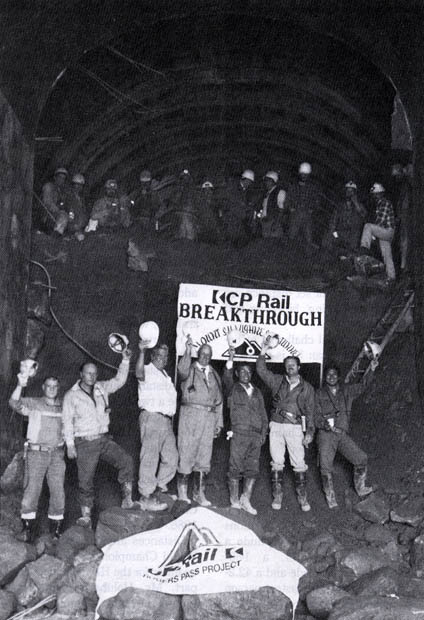Vol. 17 No. 6
June, 1987
|
Stay Safe in 87
|
|
CP Rail
Breakthrough

After more than 23 months of blasting and
excavation through 96,000 cubic metres of rock, construction crews broke through the east end of CP Rail's Mount
Shaughnessy Tunnel at 08:01 PDT, 6 May 1987.
The 1.6-kilometre tunnel is part of the railway's $600-million Rogers Pass Project located
in the heart of the Selkirk Mountains of British Columbia.
Retaining Walls Play Key Role in Pass Project
Rogers Pass British Columbia - "Anchors aweigh", or rather "anchors to stay" is the catch
phrase at CP Rail's Rogers Pass Project.
With more than 26,000 square metres of retaining walls tied back with soil anchors to stabilize slopes and hold the
new main line in place, engineering crews here want to make certain there are no failures.
Construction of the retaining walls began in 1984. Since then on-going monitoring is providing data to
help CP Rail engineers make last minute adjustments to these critical structures.
To protect for future loads, questions need to be answered about what is happening behind the retaining walls. Using
sophisticated measuring equipment, data are collected concerning water build up, pressure on soil anchors, frost
penetration, and how dependent frost is on the outside temperature.
Three types of walls have been installed on the maximum 40-degree slopes along the track. The first is
made up of mesh and shotcrete.
The second is similar with the addition of huge concrete "buttons" on the outside of the wall attached to
soil anchors. These help to distribute the pressure on the wall over a larger area. These two types are built on the
upper side of the rail line.
The third type, built on slopes beneath the railbed, is made up of concrete pillars called soldier piles. These
pillars are placed every three metres with concrete panels in between.
This CP Rail News article is copyright
1987 by the Canadian Pacific Railway and is reprinted here with
their permission. All photographs, logos, and trademarks are the property of the Canadian Pacific Railway
Company.
|